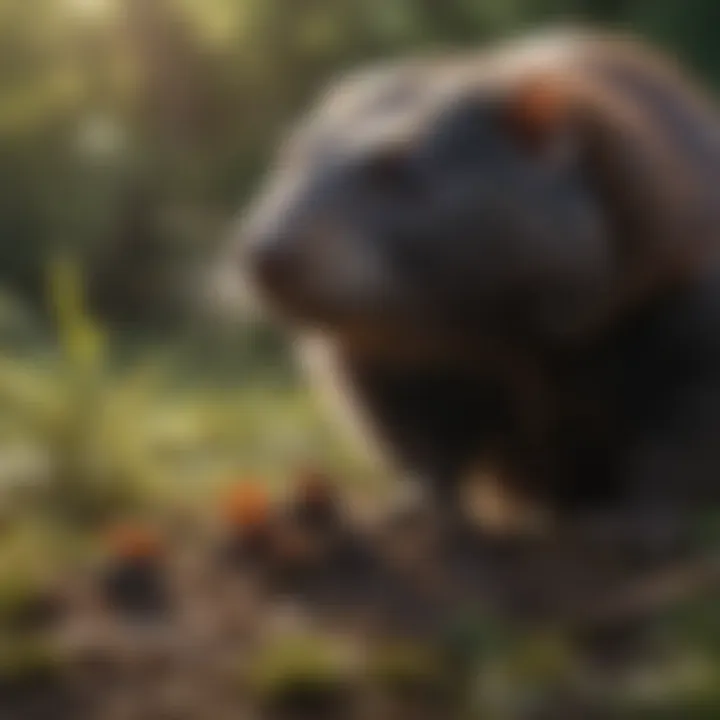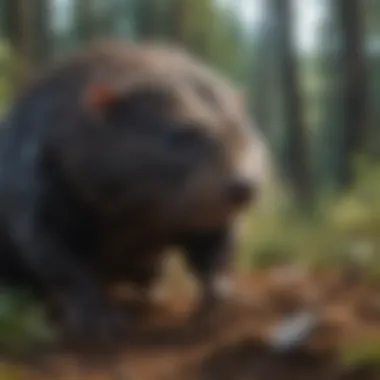Exploring Mole Predators: Their Ecology and Effects


Intro
In the ever-turning wheel of nature, every organism, no matter how small or unassuming, plays a part. Probably one of the less-lauded figures in this ecological drama is the mole, a creature often more feared than understood. At the same time, we see a cast of characters intoxicated by the thrill of the hunt—mole predators. This article opens a window into this multifaceted relationship between moles and their hunters, shedding light on how this dynamic influences ecosystems at large.
It's tempting to think of predators as simple killers, but the interactions at play are rich and complex. Predators like foxes, owls, and weasels don’t just thin the mole population; they actively shape the environment in ways both subtle and profound. In engaging with this topic, we will explore the species involved, their hunting techniques, and how moles have evolved to survive in the face of such threats.
This exploration isn't merely academic or for the sake of curiosity. Understanding the impact of mole predators helps us grasp larger ecological principles, including food web dynamics and population control. Just as the tree's shade affects the underbrush, so too does the presence of these predators reshuffle the roles of various species within their ecosystems. Embracing this perspective paves the way for better conservation efforts, balanced habitats, and more thoughtful management of wildlife.
Let’s delve into the research context that lays the groundwork for our discussion.
Prelude to Mole Predators
Understanding mole predators is crucial to unraveling the intricate web of life in various ecosystems. These predators play a significant role in controlling mole populations, which, in turn, affects the broader ecological balance. By examining who these predators are and their impact on moles, we gain insights into both predator-prey dynamics and the health of the ecosystems they inhabit.
Defining Mole Predators
Mole predators encompass a range of species that hunt or consume moles. Predation, in this context, is not just about survival; it is part of an evolutionary dance that shapes the characteristics of both predator and prey alike. Common mole predators include birds of prey, like hawks and owls, as well as various mammals such as raccoons and badgers. Additionally, some reptiles, like certain snakes, also target moles. Understanding these predators involves recognizing their behaviors, habitats, and hunting strategies. For instance, a red-tailed hawk, perched high above a lush field, has the keen eyesight necessary to spot a mole burrowing below the surface.
Significance in Ecosystem Dynamics
The role of mole predators in ecosystem dynamics cannot be overstated. Predation can regulate mole populations, providing a natural check against overpopulation, which can lead to soil degradation and other ecological issues. When predators keep mole populations in balance, they contribute to healthier soil and vegetation growth.
"The presence of predators not only influences prey populations but also has cascading effects through the food web."
In assessing the significance of these interactions, one must take into account factors such as:
- Nutrient cycling
- Soil aeration
- Plant health
When top predators thrive, the ecosystems they inhabit generally demonstrate higher levels of biodiversity. This nexus between predator and prey reminds us that every creature, no matter how small, holds a role in the grand scheme of nature.
Common Predator Species
Understanding the various common predator species that hunt moles is vital to grasping the broader ecosystem dynamics at play. These predators play a significant role in maintaining the balance of the environment. They can affect mole populations, which in turn may influence soil health and plant communities. By examining the characteristics and behaviors of these predator species, one can appreciate their fundamental contributions to ecological health.
Birds of Prey
Hawks
Hawks, with their sharp talons and keen eyesight, stand out as formidable mole hunters. They primarily hunt from high perches, scanning the ground for movement. This adaptation allows them to efficiently spot moles probing just below the surface of the soil. Hawks are known for their agility and speed, which make them excellent at swooping down to catch prey in a fraction of a second.
The key characteristic of hawks is their acute vision, which enables them to detect even the slightest disturbances in the ground. This ability confirms their role as essential predators in the ecosystem. Their effectiveness at keeping mole populations in check makes them a beneficial focus of this discussion.
Moreover, hawks contribute positively to the local biodiversity. Their hunting helps manage not just mole populations, but also influences the distribution of other small mammals and insects that share similar habitats. Hawks, therefore, provide a natural form of pest control, benefiting agriculture and promoting healthier soil ecosystems.
Owls
Owls are particularly interesting due to their unique hunting adaptations. Nocturnal creatures, they are equipped with a highly developed sense of hearing to locate prey in darkness, relying less on sight than their diurnal counterparts like hawks. Their silent flight aids in sneaking up on unsuspecting moles beneath the surface.
A hallmark of owls is their ability to rotate their heads almost completely. This characteristic not only enhances their field of vision but also enables better detection of sounds. Unlike many birds, owls have specialized feathers designed to minimize noise, making them stealthy hunters in the night.
In the context of predation’s impact on mole populations, owls engage in a unique tactic. They often use the same nest sites year after year, creating a concentrated area of hunting activity. This could lead to fluctuations in mole populations, showcasing a different aspect of predator-prey dynamics in ecosystems.
Mammalian Predators
Racoon
Raccoons are omnivorous mammals known for their dexterous front paws and inquisitive nature. While primarily known for raiding garbage cans, raccoons also hunt for moles, particularly when other food sources are scarce. Their adaptability gives them an edge in various habitats.
The key characteristic of raccoons is their intelligence, which enables them to find innovative ways to dig out moles. In the context of this article, understanding their behaviors helps illustrate how mammalian predators interact with mole populations. Raccoons are not just opportunistic feeders but also impact the local food web by their predation.
However, the downside to raccoon predation is their potential to cause significant disturbance in the environment. Their digging habits might lead to soil erosion or affect plant root systems, impacting the broader ecosystem negatively while they hunt for moles.


Badgers
Badgers are robust and powerful diggers, making them incredibly efficient predators of moles. Their stout bodies and strong claws allow them to burrow through the earth, sometimes chasing moles in the tunnels they create. Badgers are also known for their nocturnal habits, making them proficient hunters during the night.
The notable trait of badgers is their territorial nature. They often maintain specific hunting grounds, fostering a consistent interaction with mole populations within these areas. This behavior can lead to localized impacts, as badgers might exert substantial pressure on moles, affecting their population density more directly than other predators.
While badgers contribute to controlling mole numbers, their interference in habitats can lead to altered soil structure and plant communities, illustrating both a predatory and environmental influence in ecosystems.
Reptilian Threats
Snakes
Snakes, though less often recognized as mole predators, play a surprising role in this dynamic. Many species, especially those that are burrowing or semi-aquatic, have developed a taste for small mammals like moles. Their unique mode of hunting involves stealth, striking when the opportunity arises.
A prominent feature of snakes is their ability to blend into their surroundings, using camouflage to ambush unsuspecting prey. This characteristic allows them to effectively ambush moles when they emerge from their burrows. Snakes thus contribute to regulating mole populations and offer an additional layer of predatory pressure in ecosystems.
However, one downside is that some snake species are also facing population declines due to habitat destruction and human intervention. This could lead to an imbalance in predator-prey dynamics, necessitating an understanding of their role alongside other mole predators.
Lizards
Lizards, while not traditional mole predators, can impact young moles or the eggs of moles. Certain species are known to scavenge on smaller mammals or dig through soil to find nests, which could inadvertently affect mole populations, particularly in vulnerable stages. Their role in the ecosystem spans beyond direct predation, helping maintain a balanced habitat generally.
Typically, lizards are characterized by their keen senses and swift movements, allowing them to capture small prey. Their presence in the ecosystem promotes biodiversity and suggests that even smaller creatures play a part in the intricate web involving moles. Lizard activity highlights the interconnectedness of predator species with broader ecological dynamics.
In summary, each predator category—birds, mammals, and reptiles—brings distinct characteristics and hunting strategies that contribute uniquely to the ecological role of mole predators. The complexity of these interactions underscores the importance of studying such dynamics in understanding the balance of ecosystems.
Behavioral Adaptations of Moles
Understanding the behavioral adaptations of moles is essential as it highlights their survival strategies in the face of predation. These adaptations are not just fascinating; they are pivotal in ensuring that moles can maintain their populations amidst various natural enemies. Behavioral patterns can greatly affect their role within the ecosystem, ultimately influencing soil health and the dynamics of food webs. The more we comprehend these instincts and responses, the more we can appreciate the interconnectedness of life forms and their behaviors across different habitats.
Burrow Structure as Defense
Moles are well-known for their extensive tunnel systems, which serve multiple purposes, including foraging, nesting, and defense. One of the most remarkable aspects of these burrow systems is their intricate structure. Moles construct their tunnels with care, creating an elaborate network that can be quite challenging for predators to navigate.
The burrowing strategy allows moles to evade danger effectively. Here are some key features of their burrow structure:
- Depth Variation: Moles often dig at varying depths, allowing them to escape surface threats.
- Multiple Entrances: By having several exits, moles can quickly change paths when they detect predators.
- Accoustical Shielding: The surrounding soil acts as a sound dampener, helping moles to hear approaching dangers before they become apparent.
These features of burrow structure contribute significantly to their defensive behavior. Predators such as hawks and raccoons may find it laborious, if not near impossible, to reach their prey within these tunnels. As a result, moles can maintain an effective and safer lifestyle underground, where they can prosper away from the prying eyes of their predators.
Chemical Signals and Sensory Adaptations
Apart from their architectural ingenuity, moles have evolved several sensory adaptations that enhance their survivability. The subterranean life comes paired with unique challenges, particularly concerning their ability to detect threats. Moles rely heavily on chemical signals and their enhanced sensory adaptations to navigate their world and respond to potential dangers.
- Olfactory Sensitivity: Moles possess an acute sense of smell, allowing them to detect the pheromones of potential predators or the trails left by other animals. This sensitivity provides crucial information about the presence and proximity of possible threats.
- Vibratory Sensing: Moles are equipped with specialized sensors in their snouts that pick up vibrations in the soil. This ability enables them to sense larger animals moving nearby, giving them a chance to retreat before being spotted.
Through these chemical and sensory adaptations, moles are not merely passive victims in their environment. Instead, they actively monitor and respond to their surroundings, which helps them avoid encounters with predators. Their adaptations reflect a fascinating interplay between the pressures of predation and the evolutionary strategies molded to counter those pressures. The intricate dance that occurs underground plays a critical role in sustaining mole populations and, by extension, the ecological balance.
"Understanding the behavioral adaptations of moles offers deep insights into how they thrive amid a web of predators, enriching our comprehension of ecological dynamics."
By delving into these complex aspects of their behavior, we not only gain a clearer picture of mole survival but also an appreciation for the delicate balance that exists between all organisms in their ecosystem.
Predation Impact on Mole Populations
Understanding the predation impact on mole populations offers insight into the delicate balance maintained within ecosystems. Mole predators serve as a natural check on mole numbers, helping to regulate their populations. This regulation is particularly vital since unchecked mole populations can lead to significant soil disturbances and damage to plant life. Thus, the role of predators cannot be overstated; as part of a greater ecological puzzle, they influence not just the survival of moles but also the health of the larger environment.
Population Control Mechanisms
Predators utilize various strategies to control mole populations, each with its own ecological ramifications. The relationship between predators and moles highlights a fascinating aspect of nature’s design. The primary control mechanisms include:
- Natural Selection: Certain predator species have evolved specific hunting techniques that affect mole survival. For instance, owls employ their acute auditory skills to locate moles underground, allowing them to hunt effectively, especially at night.
- Behavioral Adaptations: Moles, aware of their predators, might change their habits to minimize risk. This can involve altering their foraging patterns or staying deeper underground. Such adaptations can indirectly affect their population dynamics.
- Ecological Resilience: A balanced ecosystem typically accommodates various predator-prey relationships, where too few predators can result in a rapid increase in mole populations. It protects biodiversity by ensuring that no single species dominates.
"Every player in an ecosystem, from the smallest microbe to the largest predator, contributes to an interlinked dance of survival. Remove one link, and the entire chain could falter."


In simple terms, these population control mechanisms reflect the feedback systems present in an ecosystem. Over time, these predators have ensured that mole populations do not grow unchecked, preserving the soil's integrity and overall biodiversity.
Effects of Predation on Reproduction Rates
Predation doesn't just control the number of moles; it also plays a pivotal role in their reproductive rates. When predators are prevalent in an environment, moles often respond by altering their breeding behaviors. Some of the significant effects include:
- Stress Response: Moles under threat from predators might have lower breeding success due to stress. High predation pressures can push them to delay reproduction or reduce the number of offspring produced.
- Territory Establishment: Mating behaviors are closely related to the establishment of territory. With predators in the vicinity, moles may be less inclined to venture out to establish territories necessary for attracting mates. This can lead to fewer reproductive opportunities.
- Survival of the Young: Predation risk could also affect the survival rates of young moles. If predator presence is strong, adult moles may prioritize their survival over the care of their young.
Mole populations, thus, do not solely thrive on the ground; they must contend with their surroundings, adapting constantly in a struggle for survival against their predators. This intricate balance underscores the importance of understanding how predation influences not only population numbers but also the future of mole species within their respective habitats.
Ecological Role of Mole Predators
The consquences of mole predation extend beyond just mere survival instincts of moles; they weave complex narratives into the fabric of ecosystem dynamics. These relationships between moles and their predators create a ripple effect that influences various components of their habitats. Understanding this ecological role allows for a clearer view of how biodiversity is maintained and the health of the ecosystem as a whole.
Mole predators regulate mole populations and enforce a natural balance. This balance is vital in preventing overpopulation of moles, which can lead to extensive soil disruption and vegetation damage. The actions of these predators create a mosaic of interactions that constitute the ecosystem's health.
Niche Dynamics and Food Web Interactions
In ecological parlance, the niche of an organism refers to its role within a community, and for mole predators, this role is multifaceted. By preying on moles, these predators help maintain the delicate balance of their ecosystems. They are part of a larger food web, linking various trophic levels together.
Mole predators fall into different categories, ranging from birds, such as hawks, to mammals like badgers. Each of these species plays a distinct role and influences different aspects of the ecosystem. For example, when a hawk swoops down for its meal, it not only reduces the mole population but also aids in preventing the unchecked spread of earthworms and other soil-dwelling organisms. This, in turn, promotes plant health, as a balanced number of these organisms fosters nutrient cycling in the soil.
"The removal of just one type of predator can lead to a cascade of ecological repercussions that affect everything from soil structure to plant diversity."
When predator populations fluctuate—whether due to environmental changes or human interventions—the dynamics of these niches can shift dramatically. Such shifts can disrupt the entire food web, illustrating just how interconnected these relationships are.
Implications for Soil Health
The implications of mole predation extend to soil health, a key aspect of terrestrial ecosystems. Through their predation activities, mole predators influence the fate of soil health in a few critical ways.
- Nutrient Cycling: Mole predators, by keeping mole populations in check, ensure that creatures such as earthworms can thrive at appropriate levels. Earthworms are fundamental for soil nutrient cycling, aeration, and overall fertility.
- Soil Structure: Healthy populations of earthworms and other soil-dwelling organisms promote soil structure, preventing compaction and enhancing water retention. The loss of predator pressures can lead to overpopulation of moles, prompting excessive burrowing and destabilization of soil.
- Plant Growth: With an appropriate balance of moles and their predators, plants benefit from improved soil conditions. Plants rely on nutrient-rich soil to grow effectively, and when predators maintain this equilibrium, it supports the health of entire plant communities.
Human Influence on Predator-Mole Interactions
The interactions between mole predators and their prey are not immune to the effects of human activities. In fact, these human influences have become an increasingly significant part of the ecological puzzle that shapes predator-mole dynamics. Understanding the ramifications of habitat alteration and pesticide usage is essential for grasping how these relationships are formed and transformed in the modern landscape. As we dive deeper into these aspects, we find that our actions can directly benefit or jeopardize not only the species involved but also the overall health of the ecosystem.
Habitat Modification and Its Effects
Habitat modification, often driven by urbanization or agricultural expansion, has a profound impact on predator-mole interactions. The transformation of natural landscapes into human-dominated settings can lead to the fragmentation of habitats. This alteration creates isolated patches where moles may thrive but also makes them vulnerable to predators that have adapted to exploit these new environments.
When forests are cleared for farmland or urban dwellings, the intricate web of life that supports various species can become unraveled. Certain predators, like hawks and owls, might find new hunting grounds in these modified habitats, increasing the pressure on local mole populations. Interestingly, some predators might adapt their hunting behaviors accordingly. For example, badgers might become more prevalent in these environments due to an increased availability of mole tunnels.
However, not all adaptations are beneficial. The loss of biodiversity caused by habitat destruction leads to a decline in specific predator species, which can upset the balance in the food web. This creates a ripple effect that further influences mole populations. If a natural predator declines, other opportunistic species might fill the void, leading to potentially higher predation rates. Here, the concept of ecological succession comes into play, suggesting that the evolving dynamics may lead to unforeseen consequences for both moles and their predators.
- The key implications of habitat modification include:
- Increased accessibility for predators resulting in higher predation rates on moles.
- Fragmented habitats affecting predator movement and hunting efficiency.
- Declines of specialized predator species leading to new ecological dynamics.
The Role of Pesticides in Predator Populations
Pesticides present another layer of complexity in the interactions between moles and their predators. The application of these chemicals in agriculture and landscaping often targets specific pests. Nevertheless, the indiscriminate nature of many pesticides can inadvertently affect non-target species, including both moles and their predators. The consequences can be significant; for instance, secondary poisoning occurs when predators consume moles that have accumulated toxic substances in their bodies.
The decline in predator populations due to pesticide exposure can create a paradox. Initially, the moles might experience a short-lived respite from predation. Yet, over time, the lack of natural population controls may lead to a surge in the mole population. This unregulated growth could result in detrimental impacts on soil health and agricultural practices, as moles are known for their extensive tunneling activities.
On the flip side, certain predators that are more resistant to pesticidal effects may thrive. This can skew the predator community, creating an imbalance and potentially leading to increased predation pressure on moles that have become accustomed to minimal threats.
Key considerations regarding pesticides include:
- Addressing non-target species in pesticide legislation.
- Recognizing the long-term ecological impacts of chemical use.
- Understanding feedback loops that emerge between predator-prey dynamics and human interventions.
"Preventative measures and responsible pesticide usage are crucial for maintaining balanced ecosystems, keeping natural predator-prey relationships intact."
Ultimately, the intricate dance of ecology is influenced profoundly by human actions. As we acknowledge that our choices can sway the tide of predator-mole interactions, it becomes imperative to advocate for sustainable practices that support biodiversity. Only by doing so can we preserve the delicate balance that underpins the work of nature.


Research Methodologies in Studying Mole Predators
When we think about the study of mole predators, it's like trying to piece together a jigsaw puzzle where all the pieces are buried underground. Research methodologies play a critical role in uncovering the labyrinth of interactions between moles and their predators. These methodologies not only help us understand the behaviors and dynamics at play but also provide valuable metrics for conservation and management efforts.
Field Studies and Observations
Field studies serve as the backbone of ecological research. They enable scientists to observe mole predators in their natural habitat, providing insights into their predation patterns and interactions within the ecosystem. For instance, when field researchers set up observation posts near mole burrows, they can witness real-time predator activities, such as hawks swooping down or badgers sniffing around for the hidden moles.
Such observations yield data on:
- Predator Behavior: Understanding how different predators, such as owls and raccoons, track their prey can inform us about their hunting strategies and the environmental adaptations they’ve developed.
- Mole Population Dynamics: Monitoring the fluctuations in mole populations corresponding with predator activity sheds light on the balance of ecosystems. It’s fascinating to note that during specific seasons, certain predators, like snakes, might become more active, thereby altering the entire soil texture through their hunting habits.
"Field studies offer a raw glimpse into behavioral patterns that lab settings often cannot replicate. The soil, the sounds, all the intermingling of life above and below ground—the rich tapestry it weaves is irreplaceable for ecological understanding."
Field observations come with their own set of challenges. Weather conditions can unpredictably influence predator activity, and the elusive nature of moles means that researchers must often rely on indirect evidence, like tracks or burrow measurements. Despite these hurdles, the depth and breadth of information gained from field studies is indispensable in comprehending the intricacies of mole predator relationships.
Laboratory Experiments
While field studies shine in capturing natural behaviors, laboratory experiments provide a controlled environment to tease apart specific variables at play in predator-mole interactions. Experiments may include behavioral assays, where moles are exposed to various predator cues—like urine or sounds—in a controlled setting. This can reveal how moles perceive threats and subsequently adapt their behaviors.
Laboratory experimentation can help address questions such as:
- Stress Responses: By monitoring physiological changes in moles under threat, scientists can gauge the stress levels and survival strategies employed by these creatures when predators are nearby.
- Effectiveness of Defense Mechanisms: Testing the efficacy of chemical signals that moles might use to confuse or deter their predators can contribute considerably to our understanding.
Moreover, lab settings allow for replicated experiments to gather quantifiable data, which can enhance the reliability of findings. However, some argue that laboratory conditions may not entirely capture the complexities of natural behaviors, emphasizing the importance of balancing lab work with field studies.
Future Directions in Research
Research on mole predators and their influences paints a clear picture of complex ecological relationships. It’s important to stay up-to-date with emerging methodologies and conservation needs. This section will highlight how future research can bolster our understanding of these dynamics.
Conservation Strategies for Mole Predators
Conservation strategies are crucial for sustaining populations of mole predators. Growing awareness about their roles leads to better protection measures. Creating protected areas ensures these predators have habitats that support their needs. Here are some key approaches to consider:
- Habitat Preservation: One of the most effective strategies is preserving natural habitats. This supports not just predators but entire ecosystems. The balance within these environments often relies on healthy predator populations.
- Public Awareness Campaigns: Engaging communities can foster an appreciation for these creatures. Informational sessions or educational materials can highlight the ecological significance of mole predators.
- Research Initiatives: Ongoing studies must be supported. They provide vital data about predator behavior and population dynamics. For instance, understanding how predators adapt to changing environments can inform conservation tactics.
Implementing these strategies requires collaboration among researchers, conservationists, and local communities. Only then can we truly protect the intricate balance in which these predators exist.
Integrating Technology in Ecological Studies
The integration of technology into ecological research opens up new avenues for understanding mole predators. Utilizing modern tools can enhance data collection and analysis. Consider the following:
- Remote Sensing: Employing satellite imagery or drones allows for large-scale habitat assessments. Researchers can monitor environmental changes and their impacts on mole populations and their predators.
- GPS Tracking: By fitting predators like owls or snakes with trackers, scientists gain insights into their hunting patterns and territory use. This data can reveal critical information about the density and behavior of mole predators.
- Camera Traps: These devices can record predator activities without intrusive observation. The footage provides a wealth of information on interactions within the food web and the frequency of predation on moles.
Combining these technological advancements with traditional ecological methods offers a holistic view of predator-prey dynamics. Not only does it enhance our understanding of mole predators, but it also aids in developing more effective conservation strategies.
Future research holds the potential to reshape how we view and protect mole predators in our ecosystems.
By taking stock of these future directions in research, we can progress toward a richer understanding and, ultimately, a healthier ecological balance.
Ending
The conclusion serves as a critical component of this discussion, encapsulating essential insights drawn from the intricate relationships between mole predators and their ecological roles. It is vital to appreciate how these predators work not only to maintain the balance within their ecosystems but also to protect the biodiversity that thrives within these habitats. The multifaceted nature of these interactions is highlighted through various factors such as predation rates, population control, and the impacts on soil health.
Summary of Key Findings
In summary, the investigation revealed several noteworthy findings:
- Diversity of Predators: Mole predators range from birds of prey, like red-tailed hawks and owls, to various mammals including raccoons and badgers. Each species contributes differently to the food web.
- Adaptations of Moles: Moles exhibit a range of behavioral adaptations, such as complex burrow systems and sensory modifications, to evade predation.
- Ecological Impacts: The predation of moles influences soil structure and nutrient cycling, emphasizing the interconnectedness of predators and the ecosystem.
Understanding these dynamics enhances our knowledge of local biodiversity and the overall health of the ecosystem. Moreover, the delicate balance between mole populations and their predators is crucial for developing informed conservation strategies.
The Importance of Understanding Ecological Relationships
Recognizing the intricate web of interactions among different species is essential for several reasons:
- Biodiversity Conservation: An understanding of these relationships helps in formulating effective conservation practices aimed at protecting both predators and their prey, ensuring a diverse ecosystem.
- Ecosystem Management: Knowledge about predator-prey dynamics can guide land management decisions promoting healthy ecosystems. This includes techniques for habitat restoration and pest control.
- Educational Outreach: By raising awareness about the roles of mole predators within the ecosystem, educators and researchers can foster greater appreciation for wildlife and encourage community involvement in ecological conservation efforts.
To sum up, recognizing the interconnected roles of mole predators and their prey feeds into our larger understanding of ecosystem health and resilience. The findings underscore the necessity for ongoing research and dialogue to ensure that these ecological relationships are preserved in the face of environmental challenges.















